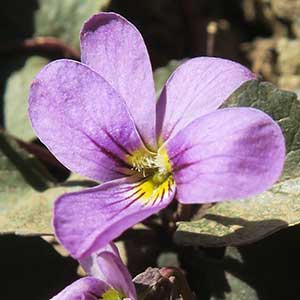Viola flettii
Viola sempervirens
Flett's violet, Olympic violet, rock violet
evergreen violet, redwood violet, redwoods violet, trailing yellow violet, violette toujours verte
1–3, ascending to erect, mostly glabrous, on caudex from fleshy rhizome.
1–5, prostrate, spreading, glabrous or sparsely puberulent, from current and/or previous year’s growth, on usually vertical, fleshy rhizome, rooting and forming rosettes at or near tip; rooted rosettes often develop into an erect, fleshy caudex from which new stems are produced.
basal and cauline;
basal: 1–3;
stipules linear-lanceolate, margins entire or with glandular processes, apex acuminate;
petiole 1.5–9.7 cm, mostly glabrous;
blade purple-tinted and –veined, broadly reniform to ovate, 0.9–2.4 × 1.2–4 cm, base cordate, margins finely crenate-serrate, eciliate, apex acute to obtuse, surfaces glabrous or sparsely pubescent along veins adaxially;
cauline similar to basal except: stipules ovate to lanceolate, margins entire or shallowly laciniate;
petiole 0.7–5.9 cm, usually glabrous;
blade 0.8–2.1 × 1.2–3.1 cm.
evergreen, basal and cauline;
basal: 1–6(–10);
stipules deltate to ovate or linear-lanceolate, margins entire or glandular-toothed, apex acute to long-acuminate;
petiole 2–16 cm, glabrous;
blade often purple-spotted abaxially and/or adaxially, orbiculate to ovate, 1–4.5 × 2–3.9 cm, base cordate to truncate, margins crenate, eciliate, apex blunt to obtuse, mucronulate, surfaces glabrous or with scattered bristles on one or both surfaces;
cauline similar to basal except: stipules deltate to lanceolate, margins entire or sparingly toothed;
petiole 0.3–3 cm;
blade 1.2–2.2 × 1.2–2 cm.
1.8–7.1 cm, usually glabrous.
5–10 cm, glabrous.
sepals lanceolate, margins eciliate, auricles 0.5–1.5 mm;
petals soft reddish violet on both surfaces, all with yellow area basally, lower 3 dark violet-veined, lateral 2 bearded, lowest with white around yellow area, 10–15 mm, spur yellow, gibbous, 0.5–2 mm;
style head bearded; cleistogamous flowers axillary.
sepals lanceolate to ovate-lanceolate, margins eciliate, auricles 1–2 mm;
petals lemon-yellow on both surfaces, lower 3 and sometimes upper 2 brownish purple-veined, lateral 2 bearded, lowest 8–17 mm, spur yellow or whitish, gibbous, 1–2.5 mm;
style head bearded; cleistogamous flowers axillary.
± spherical, 5–9 mm, glabrous.
mottled with purple, spherical to ovoid, 5–8 mm, glabrous.
dark brown to brownish purple, 2.5–3 mm.
brown, tinged purple, 2–2.5 mm.
= 24, 48.
Viola flettii
Viola sempervirens
Viola flettii is endemic to the Olympic Mountains of northwestern Washington. C. S. McCreary (2005) noted that although morphologically and ecologically distinct, V. cuneata, V. flettii, and V. ocellata are closely related.
(Discussion copyrighted by Flora of North America; reprinted with permission.)
In California, Viola sempervirens occurs in shaded redwood forests and other coastal forest habitats. In Oregon and Washington, it occurs in Douglas fir and other coniferous forests, where it can form mats (clones) one meter or more in diameter; its prostrate, spreading growth habit is similar to V. walteri. The leafy stems of V. sempervirens are similar to the leafy stolons of V. odorata.
(Discussion copyrighted by Flora of North America; reprinted with permission.)
- Local floras:
BC,
CA,
OR,
WA
- Local Web sites:
CalFlora,
CalPhotos,
Flora NW,
PNW Herbaria,
Turner Photog.
WildflowerSearch
iNaturalist (observations)
USDA Plants Database
- LBJ Wildflower Center
- SEINet
- Plants of the World Online
- Encyclopedia of Life
- Wikipedia
- Google Image Search


